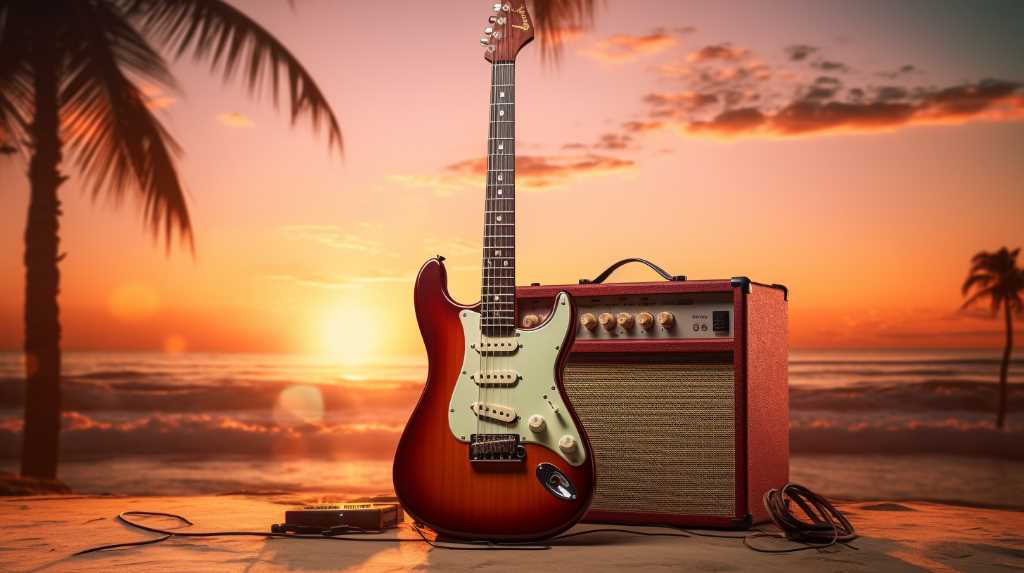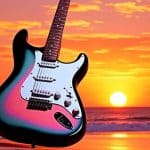
The surf guitar sound, which makes you think of the beach and sunshine, is timeless and very recognizable. To get the perfect surf guitar sound, you need the right gear, settings, and playing techniques. These all add their own special sound to the music.
The echoes in the guitar playing bring to mind the ocean, and the quick, sharp picking is like the ocean’s waves. Looking closely at these parts shows how complex it is to make this special kind of music. You need effects pedals like reverb and tremolo, and how you use them can be different for every guitarist. The amplifier you choose and how you set it up also has a big impact on the sound.
When we break down the surf guitar sound, we see how the gear and the player’s actions work together to make a sound that lasts and brings up images. Let’s dive into the world of surf guitar effects. Every little change can lead to new discoveries in making this kind of music.
To make things simpler, here are some specific tips:
- Use a reverb pedal to get that echoey sound. A good choice would be the Fender ’63 Reverb pedal.
- For the wavering effect, a tremolo pedal like the Boss TR-2 can help you get the right sound.
- When choosing an amplifier, something like the Fender Twin Reverb can give you that bright, splashy tone that surf music is known for.
- Practice techniques like quick picking and using a whammy bar for more expression in your playing.
By following these tips and experimenting with your equipment, you’ll be able to capture that classic surf music vibe in your guitar playing.
Understanding the Surf Sound
The surf sound, known for its clear, reverberating tone, comes from the 1960s surf music scene on the West Coast. This sound is made using certain guitar techniques and a set of effects pedals. The key element is the heavy use of spring reverb, which makes the music sound as if it’s being played in a large, echoing hall. Fender amplifiers like the Showman and Twin Reverb are famous for producing this deep, full effect. Also, using vibrato and tremolo effects can make the sound waver and flow like the sea.
To play surf music well, you need to be good at quick, sharp picking and fast double-picking to hit the notes right.
For example, if you want to create your own surf music, start with a Fender guitar and add a reverb pedal like the Boss FRV-1 ’63 Fender Reverb or the Strymon Flint for that splashy sound. Practice keeping your picking hand steady and quick to master those rapid notes that make surf music so exciting.
Essential Effects Pedals
To get the classic surf rock sound on the guitar, there are a few key effects pedals you should think about using.
The most important one is a reverb pedal. It’s best to use a spring reverb because it gives you that echoey sound that surf rock is known for.
Another pedal you’ll need is a tremolo pedal. It makes your guitar sound like it’s pulsing, kind of like the waves in the ocean.
If you want to make your solo parts sound fuller or give your rhythm parts a rougher edge, a fuzz pedal can be really useful.
Finally, to make sure your guitar stands out clearly in the music, you could use a clean booster or a compressor. These help keep the sound level and make the notes last longer.
When you pick these kinds of pedals, you’re on your way to getting that authentic surf rock tone.
For example, the Boss FRV-1 ’63 Fender Reverb pedal is a great choice for the reverb effect because it’s designed to sound like the classic Fender spring reverb.
For tremolo, the Fulltone Supa-Trem is a popular option that many guitarists use for its smooth wave-like sound.
If you’re looking for a fuzz pedal, the Electro-Harmonix Big Muff Pi has been a favorite for many guitar players across different genres.
To keep your guitar sound clear, the MXR Dyna Comp Compressor is a solid choice that can help you with sustain and signal balancing.
Using these specific pedals will help you create the surf sound you’re aiming for.
Amps and Settings
Selecting the right guitar pedals is very important, but to really get that classic surf guitar sound, you also need the right amplifier and settings. These should make the guitar sound bright and twangy. Tube amplifiers are popular among surf guitarists because they give a warm, rich sound when played loudly. One of the best amplifiers for this style is the Fender Twin Reverb because it’s loud and clear and has a great reverb effect that sounds like ocean waves.
To set up your amplifier correctly, keep the bass and middle settings at a medium level so they don’t drown out the high notes. Turn up the treble and presence to make the guitar sound sharper and more sparkling. The reverb on the amp is important too. You should set it to a level that gives a big, splashy sound, similar to the sound of waves crashing on the beach. This is a key part of the surf sound.
Playing Techniques
To get the classic sound of surf guitar, it’s important to learn certain picking styles and how to shake the strings in a special way. You need to pick the strings back and forth quickly and accurately to play the fast, upbeat tunes that make surf music exciting. When you pick the strings near the guitar’s bridge and do it in a short, controlled way, it helps create that unique ‘beachy’ sound. It’s even better if you use a spring reverb effect, which makes the guitar sound like it’s echoing off the waves.
It’s also important to shake the strings lightly and quickly to make long notes wobble in a way that fits with the surf style. This isn’t easy and takes a lot of practice to make sure every note is clear and adds to the music’s wave-like feel.
Maintenance and Care Tips
Ensuring the longevity and pristine sound of your surf guitar necessitates a routine of careful maintenance and cleaning.
To maintain optimal performance, routinely inspect your guitar’s hardware, including strings, tuners, and bridges. Replace corroded strings to preserve tonal clarity and intonation accuracy.
Utilize a microfiber cloth to remove fingerprints and dust from the body and neck, preventing buildup that can affect the wood’s resonance.
For electronics, such as pedals and amplifiers, confirm that connections are secure and free of oxidation. Periodically clean potentiometers and switches with contact cleaner to prevent scratchy noises or signal loss.
Store your equipment in a temperature-controlled environment to prevent warping or electronic malfunction.
Adhering to these meticulous care protocols will ensure your surf guitar effects retain their characteristic vibrancy and reliability.
Conclusion
To get that classic surf guitar sound, you need the right mix of effects pedals, the correct settings on your amp, and good playing skills. It’s important to keep your gear in good shape to keep the sound quality high.
This unique surf sound has a big influence on musicians and doesn’t seem to get old. But to really nail it, guitarists must pay attention to the technical details and take care of their instruments.
Here’s how to do it:
First, use reverb and tremolo pedals to create the wet, splashy tone that’s a hallmark of surf music. Make sure your amp is set to a bright, clean tone. Then, work on your picking technique—fast and precise is the way to go.
Keep your gear clean and in good working order to avoid any loss of tone. For example, a Fender Stratocaster with a spring reverb unit and a tube amplifier can get you very close to that iconic surf sound. Remember, the key to sounding good is not only having the right tools but also knowing how to use them well.








